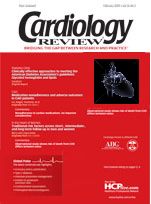Publication
Article
Cardiology Review® Online
Amiodarone drastically reduces ICD shocks
ORLANDO—Results of the Optimal Pharmacological Therapy in Implantable Cardioverter Defibrillator Patients (OPTIC) trial show that the use of amiodarone (Cordarone, Pacerone) with a beta blocking agent dramatically reduces shocks from an implantable cardioverter defibrillator (ICD) by 73% compared to the use of sotalol (Betapace) or a beta blocker alone, reported Stuart J. Connolly, MD, McMaster University, Hamilton, Ontario, Canada. “The results represent a huge reduction in shocks and a big improvement in quality of life,” he said.
“Why should we devote so much attention to reducing shocks? Because ICD patients routinely report anxiety, depression, fear of the device firing, and fear of death when the device fires,” Dr. Connolly said during the American College of Cardiology Annual Scientific Sessions. For example, a recent Mayo Clinic study reported that 24% of ICD patients have daily anxiety related to the device. Two years postimplantation, 14% of patients continue to report a daily preoccupation with their ICD.
In the 3-year OPTIC trial, patients from 39 international centers receiving a dual-chamber ICD were randomly assigned to receive a beta blocker alone (n = 136), amiodarone plus a beta blocker (n = 140), or sotalol (n = 134). Patients had documented sustained ventricular tachycardia (VT) or ventricular fibrillation (VF)/cardiac arrest with ejection fractions of 40% or less, or inducible VT or VF with either ejection fractions of 40% or less or recent unexplained syncope. The majority of patients had spontaneous VT or VF and a history of myocardial infarction. Those with long QT intervals, previous chronic amiodarone or sotalol treatment, or a need for a class I or III antiarrhythmic agent were excluded.
Beta blockers used included metoprolol (Lopressor, Toprol) at a target dose of 100 mg daily, bisoprolol (Zabeta, Ziac) at 10 mg, or carvedilol (Coreg) at 50 mg daily. Patients receiving a beta blocker plus amiodarone took 800 mg amiodarone daily for the first 2 weeks, 400 mg daily for an additional 4 weeks, and 200 mg daily thereafter. Patients in the sotalol group received 240 mg per day in two or three divided doses or 160 mg daily if creatinine clearance was 30 to 60 mL/minute. Baseline characteristics were similar for each treatment arm.
ICDs were optimally programmed for antitachycardia pacing therapy for VT episodes less than 222 beats per minute with four bursts of 10 beats, an initial burst of 85% of VT cycle length, and 12-ms decrements. Supraventricular tachycardia discrimination was turned on to detect onset, stability, and morphology with the timer set to 2 minutes.
The risk of any ICD shock dur-ing the first year after implantation was dramatically lower among patients in the amiodarone and beta blocker group compared with those taking a beta blocker alone or sotalol. “Sotalol was only somewhat effective in reducing shocks,” Dr. Connolly said.
Overall, the annual shock rate was 38.5% for beta blocker alone, 10.3% for amiodarone plus beta blocker therapy, and 24.3% for sotalol. The annual rate of appropriate ICD shocks was 22.0%, 6.7%, and 15.1%, respectively; and the annual rate of inappropriate ICD shocks was 15.4%, 3.3%, and 9.4%, respectively. The mean number of shocks per patient during follow-up was 4.32 among beta blocker patients, 0.51 in the amiodarone and beta blocker group, and 0.93 among sotalol patients. Amiodarone and beta blocker treatment reduced appropriate, inappropriate, and frequent shocks. “In the future, additional studies to measure whether reduced anxiety levels are associated with less frequent shocks will be important,” Dr. Connolly said.
Amiodarone combined with a beta blocker was also better tolerated, with 18% of patients discontinuing therapy compared with 24% of sotalol patients who discontinued therapy. Adverse events were lower overall, however, in the beta blocker alone group. Atrial fibrillation occurred in 4.4% of beta blocker patients, 0.7% of amiodarone and beta blocker patients, and in 4.5% of sotalol patients. Pulmonary adverse events occurred in 5.0% of amiodarone and 3.0% of sotalol patients and did not occur in those taking beta blockers alone. Similarly, hypo- or hyperthyroidism occurred in 5.7% of amiodarone and 0.8% of sotalol patients but in none of the beta blocker alone patients. Symptomatic bradycardia occurred in 0.7% of beta blocker patients compared with 6.4% of amiodarone and 1.5% of sotalol patients.
